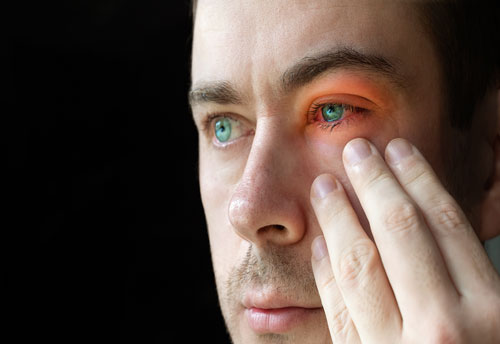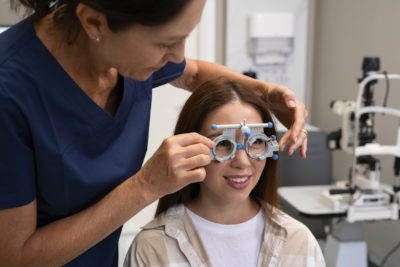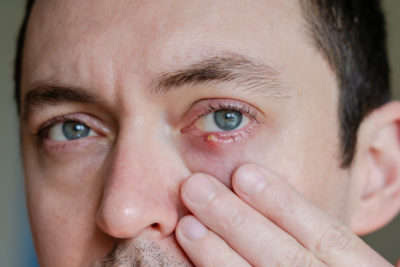The human body is a complex structure that comes into action with the help of various body organs like lungs, heart, eyes, liver, brain, and more. Hence, even if one organ begins to face any functional issue, it eventually affects the operations of all other body parts.
In this article, we will bring under purview thyroid dysfunction and its effect on the eyes or the vision of a person. When a person is affected by any type of medical condition, it is imperative to keep in mind that even though it primarily deals with one single part of the body, it has a direct or indirect effect on other body organs too.
Let us begin by understanding the basic definition of thyroid disorders and how they affect the overall functioning of the human body. In simple terms, thyroid disorders can be referred to as conditions that have a detrimental impact on the thyroid gland, which regulates multiple metabolic processes of the human body. Hyperthyroidism, and hypothyroidism are the usual manifestations of this disorder.
Thyroid Eye Diseases: How Does Thyroid Effect the Human Eye?
As mentioned above, one disease can lead to many other problems concerning different parts of the body. Thyroid eye disease is a condition in which eyelids, eye muscles, fatty tissues, and tear glands located behind the eye become swollen or inflamed, causing the eyelids and eyes to become red and uncomfortable. Additionally, the eyes can also be pushed forward in some cases, also known as the bulging or staring eyes.
However, sometimes, there is stiffness and swelling of the muscles that prevent the eyes to function in sync with each other causing double vision; in medical terms, this is known as diplopia. Now, for your comprehension, we have mentioned some of the many symptoms of thyroid eye disease below:
- A sudden change in the appearance of the eyes (staring or bulging eyes)
- Redness in eyes and eyelids
- Sharp pain behind or in the eye, especially while looking down, sideways, or up.
- Double or blurred vision
- The feeling of fullness or swelling in lower or upper eyelids
- Excessive dryness in the eyes
What if Thyroid Eye Disease is Left Untreated?
Time and again, doctors have stressed on the importance of regular body check-ups so that one doesn’t have to spend an extensive amount of time and energy on prolonged treatments. Therefore, early diagnosis is essential; on the other hand, if thyroid eye disease is left untreated, it can turn out to be sight-threatening.
Thyroid eye disease can affect the optic nerve, cornea and can also increase eye pressure, which can lead to glaucoma. The only way to prevent severe disease is to keep thyroid hormone levels under control and get a regular examination with an eye doctor, specialized in oculoplastic surgery.
Treatments for Thyroid Eye Disease
Unfortunately, thyroid eye disease still does not get the attention it deserves. Even though, oculoplastic surgeons offer an array of treatments, the general public does not know much about thyroid eye disease treatments. Further, let us throw some light on the treatments for thyroid eye disease which can broadly be categorized into two categories: medications and surgical treatments.
- Medications: When it comes to medical treatments, it is best to get in touch with a doctor who is an expert in treating thyroid-related eye conditions. However, medication for thyroid eye disease primarily includes lubricant eye drops, selenium supplementation, steroids, immunosuppressives and more.
- Surgical Treatments: Depending on the severity of the condition, there are multiple surgical treatments for thyroid eye diseases like lid retraction surgery, orbital decompression, and strabismus surgery. In order to have better clarity, we have briefly discussed all these surgeries below:
- Orbital Decompression: In simple terms, orbital decompression refers to thinning or removing safe orbital fat or orbital walls which expands the eye socket, setting the eyeball to its normal position. According to the needs of the proptosis reduction, this procedure can be customized to fulfil the patient’s cosmetic and functional needs.
- Strabismus surgery: Strabismus surgery is a simple procedure of tightening or loosening the eye muscle to change the eye’s alignment. It is employed to treat double vision and cross-eye; it is a one-day procedure, usually performed by a paediatric ophthalmologist or strabismologist. Botulinum toxin injections into the affected muscle may be used for temporary relief from double vision or muscle modification before surgery.
- Eyelid Retraction: This is a type of eyelid surgery where the height of the eyelid is adjusted to a precise position by lowering the upper eye lid or increasing the lower eyelid margin height. In most cases, this retraction is often accompanied by dry eye symptoms and corneal exposure.
World-Class Oculoplasty at Dr. Agarwals
Get the best of eye care across the globe at our 100+ hospitals spread across 11 countries. In 60+ years of caring for your eyes, we have gained the trust of 12 million patients who have applauded our diligent team of trained medical staff, expert surgeons, state-of-the-art technology, and more. From critical surgical interventions to regular eye checkups, our hospitals offer a holistic and thorough treatment for your eyes.
Our Oculoplasty department is led by expert surgeons and extensively trained staff and offers world class treatment.
For more information, visit the profiles of our renowned and professionally trained oculoplasty doctors:
Dr. Priti Udhay
https://www.dragarwal.com/doctor/priti-udhay/
Dr. Dhivya Ashok Kumar
https://www.dragarwal.com/doctor/dhivya-ashok-kumar/
Dr. Akshay Nair
https://www.dragarwal.com/doctor/akshay-nair/
Dr. Balasubramaniam S T









